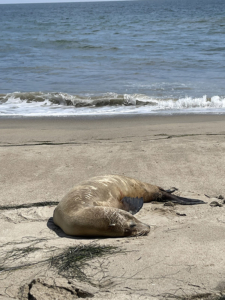2023 Summer Domoic Acid Event – A Challenging Time for Hundreds of California Sea Lions
By Marine Mammal Program Manager, Heather Henderson

California Sea Lion on Beach
You may have seen California sea lions in the news recently. Starting in June, we have been experiencing an increase in sick sea lion calls all along the Southern California coast. What has caused this?
Upwelling ocean currents along the Southern California coastline bring nutrient-rich water to the surface. The upwelling mixes deep, cool water with warmer sea surface water, resulting in an explosion of growth when sunlight is present, supporting a wide diversity of ocean life. Along with healthy growth, toxic algal blooms can also flourish. Fed by fertilizer runoff, these poisonous blooms can experience dynamic growth.
Pseudo-nitzschia is a single celled plant that has a non-toxic and toxic variety. Concentrations build up in filter feeding fish and shellfish that are consumed by California sea lions. When in the toxic form, Pseudo-nitzschia is referred to as Domoic Acid and acts as a neurotoxin. The result on the body when ingested can vary from abnormal behavior to full-body seizures, and even death. As a sentinel species, sea lions are telling us (and lab analysis has confirmed) that Domoic Acid is at unusually high levels in the Pacific. In early June, we saw the beginning of this historic mass poisoning event.
The Domoic Acid bloom synced with the pregnancies of the California sea lions, as the majority give birth in June. To prepare for nursing their newborns, pregnant females consumed dozens of pounds of fish daily, bulking up and staying in top shape. However, this June, instead of traveling out to the Channel Islands, hundreds of adult females and their pups were knocked off course. After consuming large quantities of the neurotoxin, they ended up stranded on the mainland beaches, experiencing disorientation, seizures, and even dying as a result of consuming large quantities of contaminated fish.
During the five most severe weeks of this event, CWC’s marine mammal team fielded over 800 reports of stranded California sea lions, performing 125 responses in Malibu. By comparison, a normal year will yield on average 15 responses during the same five-week timeframe.
What are the main challenges that accompany the response to a large toxic algal bloom? It arrives with little to no warning and intensifies within just a few days. Rescue programs quickly reach maximum capacity and are unable to admit every stranded animal as a patient, so triage and beach monitoring are implemented.
Can sea lions survive this massive assault on their bodies? The fortunate answer is yes! Although a mentally and physically difficult time, there were numerous successes to celebrate throughout this event. All patients currently in care are no longer displaying seizure activity and are self-feeding. 75% of the California sea lions rescued during this event survived and have been released or are on track to be released.
How can you help?
- Always give marine mammals space to relax on the beach, 50ft or more and report concerns of distressed animals to the stranding agency.
- Volunteer at your local stranding center. Safety training is essential and can only be learned by working with trained professionals who are permitted to respond.
- Donate to help purchase food and medicine for current and future events.
- Lastly, help educate your neighbors.
- If you are in Malibu and need to report a distressed marine mammal contact our Marine Mammal Rescue Team at (310) 924-7256.
